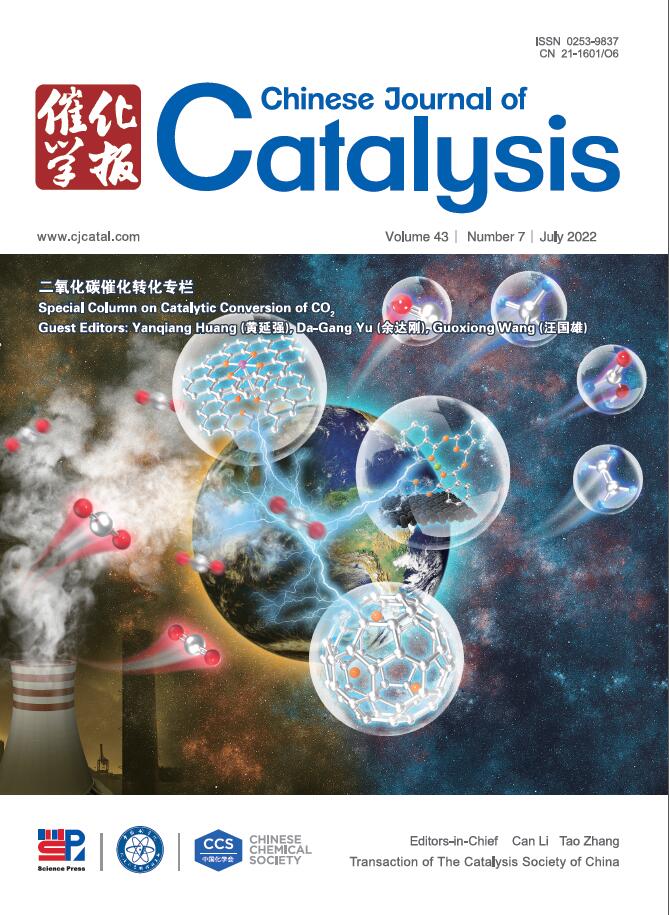Theoretical prediction of WS2-confined metal atoms for highly efficient acetylene hydrogenation to ethylene
IF 17.7
1区 化学
Q1 CHEMISTRY, APPLIED
引用次数: 0
Abstract
Precise regulation of atomic and electronic structures of two-dimensional tungsten disulfide (WS2) is significant for rational design of high-performance and low-cost catalyst for acetylene hydrogenation to ethylene (AHE), yet remains a major challenge. Herein, we report that by substituting a W atom of WS2 with a series of transition metal atoms, sulfur vacancy-confined Cu in the WS2 basal plane (Cu@WS2-Sv) is theoretically screened as a superior non-noble metal-based catalyst with higher activity, selectivity, and stability for the AHE than other candidates. The co-adsorption of C2H2 and H2 and hydrogenation of C2H3* to C2H4* are revealed as the key steps establishing a volcano-like activity trend among the candidates, which present Cu@WS2-Sv as the optimum catalyst combined with molecular dynamics and reaction kinetics analyses. The kinetically more favorable desorption of C2H4 than the over hydrogenation path validates a higher selectivity toward C2H4 over C2H6. Furthermore, a machine-learning model reveals the significant effect of d-electron number and electronegativity of the metal heteroatoms in modulating the AHE activity.
ws2约束金属原子高效乙炔加氢制乙烯的理论预测
精确调控二维二硫化钨(WS2)的原子和电子结构对于合理设计高性能、低成本的乙炔加氢制乙烯(AHE)催化剂具有重要意义,但仍是一个重大挑战。在此,我们报告了通过用一系列过渡金属原子取代WS2的W原子,在WS2基面上的硫空位限制Cu (Cu@WS2-Sv)理论上被筛选为比其他候选物具有更高活性、选择性和稳定性的非贵金属基催化剂。结合分子动力学和反应动力学分析,发现C2H2和H2的共吸附以及C2H3*加氢为C2H4*是候选物形成火山状活性趋势的关键步骤,认为Cu@WS2-Sv是最佳催化剂。C2H4的脱附比C2H6的过加氢更有利,证明了C2H4比C2H6有更高的选择性。此外,机器学习模型揭示了金属杂原子的d电子数和电负性对AHE活性的显著影响。
本文章由计算机程序翻译,如有差异,请以英文原文为准。
求助全文
约1分钟内获得全文
求助全文
来源期刊

Chinese Journal of Catalysis
工程技术-工程:化工
CiteScore
25.80
自引率
10.30%
发文量
235
审稿时长
1.2 months
期刊介绍:
The journal covers a broad scope, encompassing new trends in catalysis for applications in energy production, environmental protection, and the preparation of materials, petroleum chemicals, and fine chemicals. It explores the scientific foundation for preparing and activating catalysts of commercial interest, emphasizing representative models.The focus includes spectroscopic methods for structural characterization, especially in situ techniques, as well as new theoretical methods with practical impact in catalysis and catalytic reactions.The journal delves into the relationship between homogeneous and heterogeneous catalysis and includes theoretical studies on the structure and reactivity of catalysts.Additionally, contributions on photocatalysis, biocatalysis, surface science, and catalysis-related chemical kinetics are welcomed.
 求助内容:
求助内容: 应助结果提醒方式:
应助结果提醒方式:


